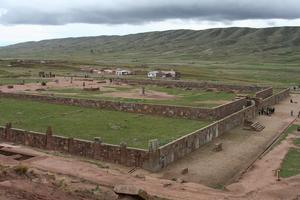Advertisement
Published: January 16th 2007

 Kalasasaya
Kalasasaya
Two acre temple with columns of sand stone. Used to calculate the seasons and to be used as a calendar with 364 (+1) days.We took a day-trip to Tiwanaku, from
La Paz . Inca culture is what most people seem to think about when talking about Peruvian and Bolivian history. However, perhaps more important, for Bolivia anyway, is the Tiwanaku period. The Tiwanaku civilisation started around 1500 BC (the earlier parts that is, some people count the start of the Tiwanaku period as being 600 BC, the temples were built around 300 AD) and ended roughly when the Incas came to power, around 1200 AD - a 2,700-year empire. Think about that! The Roman empire lasted for roughly 1,200 years, for example.
The Tiwanaku people seemed highly developed in terms of architecture and astronomy, working with a 24-hour division of each day, 365 day year, etc. As one example, they created an observatory pool, in the shape of a giant sun symbol, at the top of the Akapana pyramid, with the the kardinal points in their exact positions. How did they do that? Did they know about magnitism?
Unfortunately there's not a lot left of the Tiwanaku site. The Spanish conquest and treasure hunters have taken its toll, and the site is unfortunately in a very bad condition. Most of the artifacts have

 Woman, Man & Upper Class
Woman, Man & Upper Class
...in that order on the top row. Kids were selected at a very young age to become "upper class", and therefore more intelligent. For that you need a larger brain, so a bandage was put around the head to make it grow into the right shape.been removed from the site and stones from the temples have been used for building roads and houses, by both the Incas and the Spanish.
Nevertheless, it was an interesting experience, and parts of the site has been restored, so that you can get an idea of what it once looked like. The pyramid is however still covered by dirt. A few things are visible, the main entrance and parts of the observatory pool, among others. Excavations are ongoing, so it should hopefully me even more interesting in a few years.
There are also a couple of museums in the Tiwanaku village that are worth seeing. Here they've tried to rescue the most important artifacts from the site. A number of statues are on display, pottery and a full range of skulls, among other things. Apparently the Tiwanaku community chose the people who were to become upper class amongst two-year old children. Once they had decided who were the "lucky" ones, their heads were "bandaged" to give them a pointy look, and more space for a bigger, more clever, brain. Have a look at the photo and you'll see what we mean. Don't know if all two-year-olds had

 Main entrance...
Main entrance...
to Akapana, still early in the excavation.the same chance of becomming upper class, but it seems so. Interesting!
Tiwanaku village, located just outside the site, is a sad story though. A couple of "restaurants", of which only one seemed to be open, and a few dozen houses and of course a church. Schools of kids begging, or selling souverneirs on dirt track streets. That's it.
Vi tog en dagstur fran
La Paz till Tiwanaku. Inkakulturen ar val det folk tanker pa mest vad det galler peruansk och boliviansk historia. Men kanske mer viktigt, for Bolivia iallafall, ar Tiwanakuperioden. Tiwanakucivilisationen borjade runt 1500 BC (de tidigare delarna alltsa, en del borjar rakna ar 600 BC som borjan pa Tiwanakuperioden, templen byggdes runt 300 AD) och slutade ungefar samtidigt som Inkafolket kom till makten runt 1200 AD - ett 2700-arigt rike. Nagot att tanka pa! Som jamforelse varade romarriket ungefar 1200 ar.
Tiwanakufolket verkade vara valutvecklade vad galler arkitektur och astronomi, de hade delat upp dagen i 24 timmar och aret i 365 dagar. Ett exempel: de hade byggt en astroligisk observatoriesbassang i form av en jattelik solsymbol pa toppen av Akapanapyramiden, med hornen exakt i de fyra vaderstrecken. Hur lyckades de med det? Hade de

 Sun Gate
Sun Gate
not in the orginal position. (reverse)kunskap om jordens magnetism?
Tyvarr finns det inte mycket kvar pa Tiwanakusajten. Den spanska erovringen och skattjagare har gjort sitt, och platsen ar tyvarr inte i vidare bra skick. De flesta foremalen har flyttats fran platsen och stenarna fran templen har anvants for att bygga vagar och hus, av bade Inka och spanjorer.
Trots allt var det en intressant upplevelse, och delar av platsen har ateruppbyggts sa man kan fa en bild av hur den en gang sag ut. Pyramiden ar tyvarr fortfarande tackt av jord. En del saker ar synliga, som huvudingangen och delar av observatoriebassangen. Vidare utgravningar pagar, sa forhoppningsvis blir det annu mer intressant om nagra ar.
Det finns ocksa nagra museer i Tiwanakubyn som ar varda ett besok. Har har man forsokt radda de viktigaste foremalen fran utgranvingen. Det finns bland annat ett antal statyer, krukor och en hel samling skallar. Tydligen valde Tiwanakufolket ut vem som skulle bli overklass bland barn i tvaarsaldern. Nar man valt ut de "lyckliga" lindade man deras huvuden med bandage for att de skulle fa en toppig form med mer plats for en storre, och intelligentare, hjarna. Titta pa fotot sa forstar du vad vi menar. Vet

 Notice the calendar...
Notice the calendar...
including 48 weeks (364 days) at the top of the Sun Gate.inte om alla tvaaringar hade samma chans att bli overklass, men det verkade sa. Intressant!
Tiwanakubyn, precis utanfor omradet, ar en sorglig historia. Nagra "restauranger", bara en verkade vara oppen, nagra dussin hus och forstas en kyrka. Grupper av tiggande barn, eller som salde souvernirer, pa grusvagar. Det var allt.
Advertisement
Tot: 0.407s; Tpl: 0.012s; cc: 25; qc: 99; dbt: 0.1709s; 1; m:domysql w:travelblog (10.17.0.13); sld: 1;
; mem: 1.3mb















